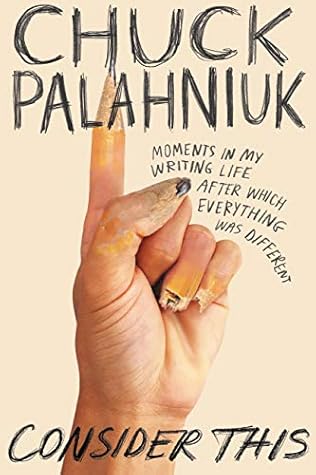More on this book
Community
Kindle Notes & Highlights
Read between
March 26 - April 2, 2020
So once you’ve established your characters and settings, give your people a glimpse of the outside world.
The larger world reminds characters of their smallness and mortality, and it prompts them to take disastrous action.
There is enormous tension in unresolved social issues. The French philosopher Jacques Derrida proposed that Western culture is binary. Things must be one way or the other. True or false. Alive or dead. Male or female. Anything that doesn’t fall clearly into one category or another drives us to distraction.
This is the reason I depict questionable behavior in my work but refuse to endorse or condemn it. Why preclude the wonderful energy of public debate?
consider other aspects of the culture that aren’t clearly resolved. To me, what first comes to mind is abortion and male circumcision. People will fight forever to defend or denounce them. As a writer your job isn’t to resolve an issue, but you can depict the situation and make use of the natural tension a topic carries.
If you were my student, I’d urge you to find some unresolvable issue that will instantly guarantee tension and debate over your work.
In old-fashioned literary terms, anytime you broach a subject yet refuse to explore it, that’s called occupatio
But the technique also covers statements such as, “You know I’d never kill you, don’t you?” Or, “He told himself not to slap her.” Anytime you deny a possibility you create it at the same time. Such statements introduce the threat they appear to be denying.
This ship is unsinkable. The canned salmon is supposed to be safe. Please don’t mention Daniel’s murder. We’re not going down that road.
I think of myself as a conduit. I am the disposable thing trying to identify the eternal thing. Experience enters and product exits.
I create a few key scenes. Maybe depicting the character’s job. How the romance begins, the “meet cute.” Or the inauthentic way in which the character gets his emotional needs met, i.e., how he fools people into loving him. Each of these must stand alone as a short story.
This arduous process of creating a complete first draft, Tom calls it “shitting out the lump of coal.” As in, “Relax, you’re still shitting out your lump of coal.”
For the record “sous-conversation” (or subtext) refers to the message that’s submerged in the actions and dialogue of the scene, the hidden extra meaning. Tom’s use of “manumission” meant the grace with which your sentences carried the reader forward without disturbing the fictional dream. To demonstrate this, he’d cup his hands and tilt them as if gently passing a small object back and forth between his
palms. A good writer must gently pass the reader from sentence to sentence, like a fragile egg, without jarring the reader out of the story.
idea or profundity that they’re compelled to push the book on others if only to have peers with whom they can discuss it.
you can plant a unique name or phrase that when searched will turn up every site on the web where your work is available. One click, and you’ve found all the illegal copies.
I will whisper a couple tried-and-true patterns that American readers always seem to embrace. Let’s call these “Tropes for Dopes,” shall we? The first is that the classic American bestseller tends to depict three main characters. One character follows orders, is shy and agreeable, a general all-round good girl or boy. The second character is largely the opposite: a rebel who bullies and breaks the rules, always brashly hogging the spotlight. And the third is quiet, thoughtful, and acts as the narrator, relating the story to the reader. The passive character commits suicide in some way. The
...more
Airships by Barry Hannah Campfires of the Dead by Peter Christopher Cathedral by Raymond Carver Drown by Junot Díaz Faraway Places by Tom Spanbauer Generation X: Tales for an Accelerated Culture by Douglas Coupland Heartburn by Nora Ephron Honored Guest: Stories by Joy Williams Jesus’ Son by Denis Johnson Miles from Nowhere by Nami Mun Slaves of New York by Tama Janowitz The Acid House by Irvine Welsh The Collected Stories of Amy Hempel by Amy Hempel The Folly of Loving Life by Monica Drake The Ice at the Bottom of the World: Stories by Mark Richard The Informers by Bret Easton Ellis
The Night in Question: Stories by Tobias Wolff The Pugilist at Rest: Stories by Thom Jones Through the Safety Net: Stories by Charles Baxter
Death in Yellowstone by Lee Whittlesey Forbidden Words: Taboo and the Censoring of Language by Keith Allan and Kate Burridge From Ritual to Theater: The Human Seriousness of Play by Victor Turner Hard Core: Power, Pleasure, and the “Frenzy of the Visible” by Linda Williams
MFA vs. NYC edited by Chad Harbach Page Fright: Foibles and Fetishes of Famous Writers by Harry Bruce The Gift by Lewis Hyde The Program Era by Mark McGurl The Rites of Passage by Arnold van Gennep The Ritual Process: Structure and Anti-Structure by Victor Turner The Sovereign Outsider: 19th Century American Literature, (Non-) Discursive Formation and Postanarchist Politics by Mathias Hagen König Trickster Makes This World by Lewis Hyde
What if all of our anger and fear is unwarranted? What if world events are unfolding in perfect order to deliver us to a distant joy we can’t conceive of at this time? Please consider that the next ending will be the happy one.


